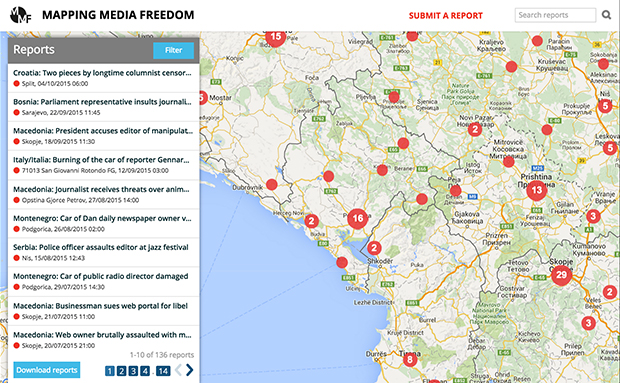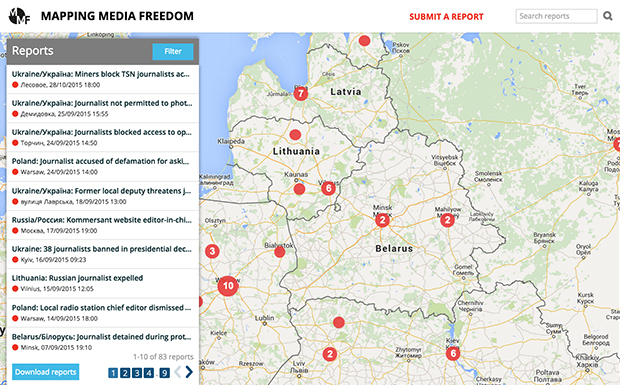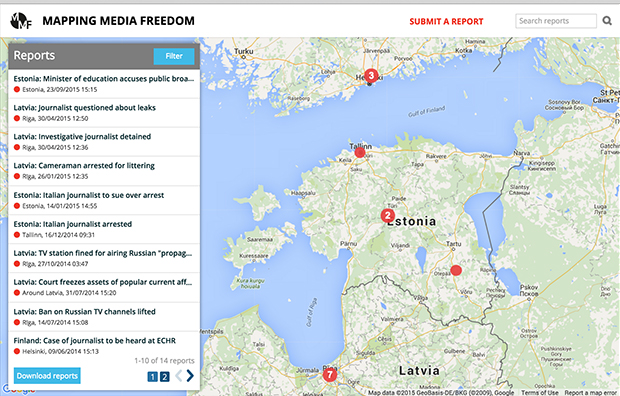14 Oct 2015 | About Index, Campaigns, Mapping Media Freedom, Press Releases
Strasbourg, 13.10.2015 – The Committee to Protect Journalists and Index on Censorship became partners to the Platform to promote the protection of journalism and safety of journalists, which will allow them to alert the Council of Europe on violations to media freedom in Europe.
“Joining the Council of Europe platform is part of our continued efforts to increase visibility of media freedom violations in the region. We look forward to working with the Council and engage in a constructive dialogue with governments to address the too many threats journalists face for simply doing their job,” Melody Patry, senior advocacy officer Index on Censorship, said.
Chief Executive of Index on Censorship Jodie Ginsberg, and European Union correspondent of the Committee to Protect Journalists Jean-Paul Marthoz signed the agreement on behalf of their organisations during a meeting with Council of Europe Secretary General Thorbjørn Jagland.
Secretary General Jagland said: “Visibility for threats against journalists is crucial and cannot be underestimated. The fact that we have this platform means that we can also take concrete threats against journalists to governments in question and discuss with them to take joint actions. We already have good examples of how this works in a positive way”.
Since its launch in April 2015, the platform has recorded 84 alerts concerning 21 states. Twenty-five alerts concern physical attacks on journalists, 21 alerts the detention and imprisonment of journalists, 8 impunity of attacks, 8 harassment or intimidation, and other 22 acts that may have a chilling effect on media freedom. Eleven alerts concerned cases in which journalists were killed, eight of them in the Charlie Hebdo attack.
The platform was launched with the participation of five partner organisations with which the Council of Europe signed a Memorandum of understanding: Article 19, the Association of European Journalists, the European Federation of Journalists, the International Federation of Journalists and Reporters Without Borders.
The platform allows these partners to issue alerts concerning media freedom threats and to bring them to the attention of the Council of Europe institutions. Once the alerts are published, the Council of Europe sends them to the authorities of the country concerned. The Council of Europe institutions may react publicly or start a dialogue on the issue with the authorities. Subsequently, responses of the member states and follow-up action taken by the competent bodies are also posted on the platform. The governments of the states concerned by the 84 alerts received have so far replied to 26 cases.
Contact: Jaime Rodriguez, Spokesperson/Media officer, tel. +33 3 90 21 47 04
——
Le Comité pour la protection des journalistes et Index on Censorship se joignent à la Plateforme du Conseil de l’Europe pour la protection des journalistes
Strasbourg, 13.10.2015 – Le Comité pour la protection des journalistes et Index on Censorship se joignent aujourd’hui aux organisations partenaires de la Plateforme pour renforcer la protection du journalisme et la sécurité des journalistes, ce qui leur permettra d’alerter le Conseil de l’Europe sur les cas de violation de la liberté des médias en Europe.
“Rejoindre la plateforme du Conseil de l’Europe fait partie de nos efforts continus pour accroître la visibilité des violations de la liberté des médias dans la région. Nous avons hâte de travailler avec le Conseil et d’engager un dialogue constructif avec les gouvernements pour confronter les menaces trop nombreuses qui pèsent sur les journalistes,” dit Melody Patry, chargé de plaidoyer principal Index on Censorship.
Jodie Ginsberg, directrice d’Index on Censorship, et Jean-Paul Marthoz, correspondant pour l’Union européenne du Comité pour la protection des journalistes, ont signé l’accord de partenariat au nom de leur organisation lors d’une réunion avec Thorbjørn Jagland, Secrétaire Général du Conseil de l’Europe.
M. Jagland déclaré : « faire connaître les menaces qui pèsent sur les journalistes revêt une importance cruciale, c’est un levier qu’on ne saurait sous-estimer. En outre, grâce à cette plate-forme, nous pouvons approcher les gouvernements concernés au sujet des menaces concrètes qui pèsent sur les journalistes, en vue de prendre des mesures conjointes. Nous avons d’ores et déjà obtenu des résultats positifs avec cette méthode. »
Depuis son lancement en avril 2015, la plate-forme a enregistré 84 alertes concernant 21 Etats. Vingt-cinq alertes portent sur des agressions physiques contre des journalistes, 21 sur la détention et l’emprisonnement de journalistes, 8 sur l’impunité des agressions, 8 sur le harcèlement ou l’intimidation, et 22 sur des actes pouvant avoir un effet dissuasif sur la liberté des médias. Onze alertes concernent des cas dans lesquels des journalistes ont été tués ; parmi ceux-ci figurent notamment huit victimes de l’attentat contre Charlie Hebdo.
La plate-forme a été lancée avec la participation de cinq organisations partenaires, qui ont signé un mémorandum d’accord avec le Conseil de l’Europe : Article 19, l’Association des journalistes européens, la Fédération européenne des journalistes, la Fédération internationale des journalistes et Reporters sans frontières.
La plate-forme permet à ces organisations de publier des alertes concernant des menaces qui pèsent sur la liberté des médias, et de les porter à l’attention des institutions du Conseil de l’Europe. Lorsqu’une alerte est publiée, le Conseil de l’Europe la transmet aux autorités du pays concerné. Les institutions du Conseil de l’Europe peuvent réagir publiquement aux alertes ou entamer un dialogue à ce sujet avec les autorités. Par la suite, les réponses des Etats membres et les suites données par les organes compétents sont également publiées sur la plate-forme. A ce jour, 84 alertes ont été reçues, qui ont donné lieu à 26 réponses de la part des gouvernements concernés.
Contact: Jaime Rodriguez, Porte-parole/Attaché de presse, tél. +33 3 90 21 47 04
13 Oct 2015 | Europe and Central Asia, mobile, Montenegro, News and features

While the physical safety of Montenegro’s journalists is far from guaranteed, a more troubling trend toward using media professionals to settle professional or business scores is undermining the country’s news outlets.
Describing mass media in Montenegro, Marijana Camovic, a journalist and head of the Trade Union of Media, says the deep-rooted division between pro-government and pro-opposition media has now reached a completely new level. Television news and newspaper front pages are filled with the “dirty laundry” of journalists that work for competing outlets, she said.
As a result of the smear campaigns, more journalists are leaving the profession.
“Before, journalists would consider leaving the job only after they found a new one, but not anymore. Nowadays there are a lot of displeased and disappointed journalists who are quitting without thinking twice.”
These departures leave empty spaces that are filled by people who are willing to work for lower wages and compromise on journalistic integrity by publishing what they are told to publish. Ethical and professional journalism is becoming scarcer, according to Camovic.
Without proper media ethics and professional solidarity, journalists are often manipulated by politicians and businessmen to advance the cause of interests contrary to their own or the public’s, says Camovic. “Media workers are being used as a tool for political pressure and the elimination of other political affiliations.”
At the same time, there has been a drastic decrease in circulation, lower advertising income and growing debts for outlets. Camovic said the Montenegrin media’s catastrophic economic condition can no longer be denied.
Camovic points out that the main issues affecting media professionals are no longer impunity or physical assaults. Today, the major areas of concern include a lack of respect for media workers’ rights and falling salaries; fair remuneration for freelancers; and the rights to unionise and collective bargaining.
However, this is not to say that journalists’ safety is no longer an issue. Take, for example, the case of Tufik Softic, who has been under constant police protection since February 2014. In November 2007, Softic was brutally beaten in front of his home by two hooded assailants wielding baseball bats, and in August 2013, an explosive device was thrown into the yard of his family home. The European Federation of Journalists (EFJ) sent an open letter to Filip Vujanovic, president of Montenegro, in June this year expressing their “regret that no concrete action has been done to bring the perpetrators, who are behind these attacks, to justice”.
As Index on Censorship’s Mapping Media Freedom project highlights, the tactics of intimidation have shifted. Between February 2014 and October 2015, there were 23 verified media violations in Montenegro. Most of those incidents involved attacks on journalists’ property, with cars being a popular target.
Last year, Human Rights Action (HRA) outlined in a report that there were 30 instances of threats, violence and murder, as well as attacks on media property between May 2004 and January 2014.
“I think that everything should be changed – from the approach towards journalism to the dynamics inside the guild,” she says. But the biggest mistake, Camovic emphasises, is that journalists are taking part in the blackmailing game, which has resulted in the absolute collapse of professional standards.
Camovic points to the almost uninterrupted 24-year political rule of Milo Dukanovic, the passivity of Montenegrin society and the absence of the rule of law as contributing to the dire situation.
Mapping Media Freedom
Click on the bubbles to view reports or double-click to zoom in on specific regions. The full site can be accessed at https://mappingmediafreedom.org/
|
6 Oct 2015 | Belarus, Europe and Central Asia, Mapping Media Freedom, mobile, News and features

In Belarus, dozens of freelance journalists were fined between 2014 and 2015 for working for foreign media without an accreditation from the Ministry of Foreign Affairs. In a country dominated by state-run media, foreign outlets offer an alternative source of information.
Under Belarusian law, freelance journalists who co-operate with foreign media outlets are not considered legal employees of the organisation in question and aren’t entitled to receive the required accreditation. The first freelancer penalised was videographer Ales Dzianisau from Hrodna, a city in western Belarus. He was accused of illegally producing a video which ran on Belsat TV — a Polish state-run channel aimed at providing an alternative to the censorship of Belarusian television — about the opening night of a rendition of Goethe’s play Faust. He was fined €300.
Under Article 22.9(2) of the Belarusian Code on Administrative Offence, the courts can judge journalistic activities without an accreditation as illegal. In each case, the reason for the journalist having committed an offence was not the content of their work, but that they were published through foreign media.
As a rule, the police must consult witnesses — usually a person who was interviewed by the journalist — to prove that a work was made by the journalist accused. This doesn’t always appear to be the case.
An article published by Aliaksandr Burakou on the German website Deutsche Welle resulted in court hearings, talks at the tax office and the seizure of flash drives and computer systems. On 16 September 2014, Burakou’s apartment was searched, as was that of his parents. The journalist was charged with work without accreditation and fined €450. Burakou’s appeal to the country’s Supreme Court was rejected in May 2015.
The Belarusian Association of Journalists (BAJ) strongly condemns the continued prosecution of freelancers. It called the prosecutions a gross violation of the standards of freedom of expression.
In December 2014, OSCE Representative on Freedom of the Media Dunja Mijatović wrote in a letter to the Minister of Foreign Affairs of Belarus, Vladimir Makei, stating: “These undue restrictions stifle free expression and free media. Mandatory accreditation requirements for journalists should be reformed as they hinder journalists from doing their job.” She reiterated her call on to stop imposing restrictive measures on freelance journalists in April 2015.
The European Federation of Journalists (EFJ) issued a statement on the situation at its June 2015 annual meeting. It called on the Belarusian authorities to drop the practice of holding freelancers accountable for work without the accreditation. The union also called on the OSCE and the Council of Europe to pay more attention to violations of freelancers’ rights in Belarus.
Nevertheless, since the beginning of 2015, 28 Belarusian journalists have been fined with 23 of those cases taking place in the last six months. Since April 2014, 38 freelance journalists have been fined €200-500, totalling over €8,000.
Dzianisau, the freelance cameraman penalised for making video reports in Hrodna, said: “The most complicated thing for me in this situation is that the authorities shut off the air. At present, I cannot report in the history museum or the museum of religions. I cannot report in the puppet theater, and now in the exhibition hall on Azheshka Street.”
Some freelancers have been brought to trial several times during this period. Kastus Zhukouski has been fined six times and Alina Litvinchuk four times. Some see the pressure on the media in Belarus as increasing due to the upcoming presidential elections on 11 October 2015.
Not so long ago, President Alexander Lukashenko was asked what should be done about journalists receiving fines. In response, he acknowledged that the practice was improper and the matter should be investigated by his press service.
However, many Belarusian freelancers do not believe their situation will change soon. Larysa Shchyrakova, a freelance journalist from Gomel who has been penalised twice this year for co-operating with foreign media, said: “I do not believe there will be any liberalisation because it is contrary to the logic of the authorities. The system in Belarus is ineffective and the prosecution of journalists will always be a priority for the government.”
Mapping Media Freedom
Click on the bubbles to view reports or double-click to zoom in on specific regions. The full site can be accessed at https://mappingmediafreedom.org/
|
2 Oct 2015 | Europe and Central Asia, mobile, News and features

On 19 September, the Estonian Minister of Education, Jürgen Ligi, accused the Estonian Public Broadcaster’s new Russian-language TV channel of disclosing secret government data.
The news report that sparked Ligi’s accusation dealt with the government’s proposal to teach high school students in Estonian. This move has been seen as ignoring the rights of the Russian-speaking minorities in the country.
Ligi implied that the report caused difficulties for the government. He also announced that, as the information was most likely leaked, there would be an official investigation. The head of the news department at the public broadcaster ETV, Urmet Kook, has already explained that the information was not received through a leak but was discovered during a routine check of public documents on different ministries.
This is the latest in a series of actions by the government against the media for disclosing data. Politicians see themselves as having a monopoly on truth and consider the press as nothing more than troublesome meddlers.
There are no specific laws relating to the media in Estonia, so all commercial outlets — apart from broadcast channels — are governed like any other business. The diverse legal landscape is subject to many different interpretations and there are no defined meanings of terms like ‘public interest’ and ‘public figure’, which makes it difficult for journalists to operate.
A typical example of the excessive limitations on the media is the Act on Defence of Personal Data. On first glance, it appears to be a noble attempt to defend sensitive information about the private lives of individuals, such as political affiliations, race and heritage. However, a closer look shows that it effectively prevents many journalists from uncovering information in the public interest. For example, a hospital denied a journalist access to information relating to a lump sum payment made in compensation for malpractice. In another case, a press officer at the Office of Public Prosecutor refused to acknowledge a criminal investigation into a well-known businessman. On both occasions, the reason for refusing to disclose the data was its sensitive nature.
Some caution is understandable. Any ethical person understands the necessity of the right to privacy. But over zealous and arbitrary enforcement makes it very difficult for journalists to warn the public of corruption, crime and dangerous individuals. With the protection offered by the act, released convicts can demand media outlets remove a story relating to their crimes, trials and sentences. Offenders can effectively hide in plain sight.
While these legal hurdles are a fact of life for many journalists, freelancers face extra obstacles. Larger media companies are given preferential treatment by the government, as are journalists who present information in the desired way. Estonian media channels also tend not to work with freelancers on a one-time basis. Such practices hurt freelance journalists, especially younger writers who lack established sources and connections. Without proper access to information, they are deprived of a proper livelihood.
Mapping Media Freedom
Click on the bubbles to view reports or double-click to zoom in on specific regions. The full site can be accessed at https://mappingmediafreedom.org/
|



